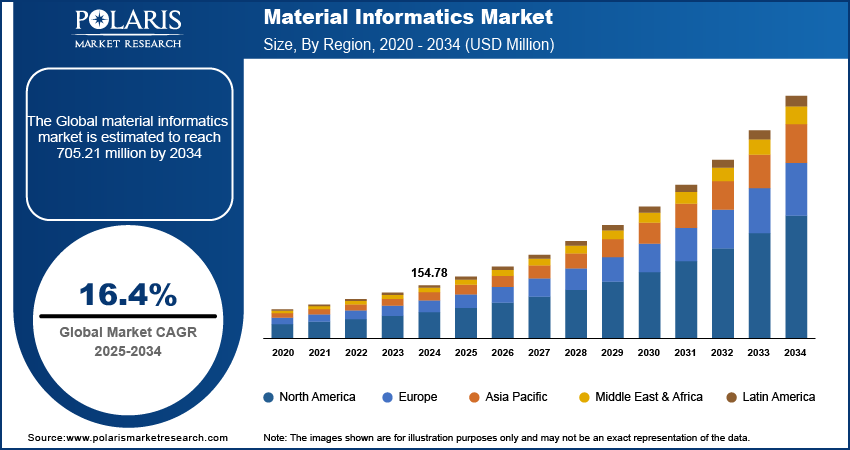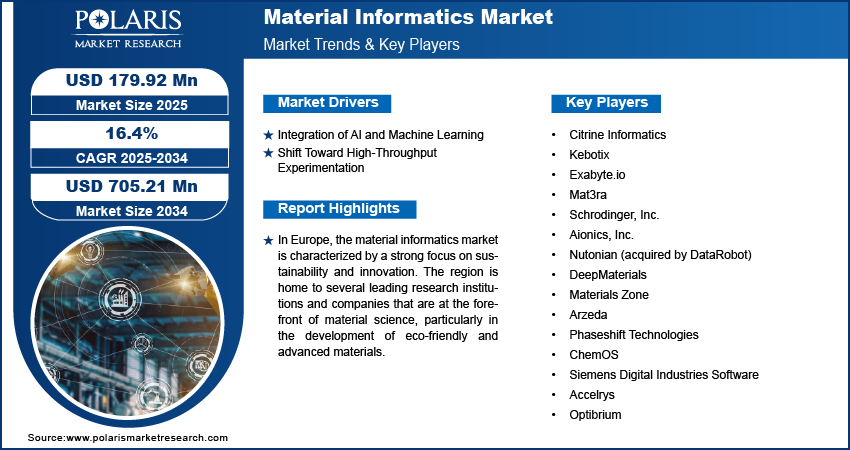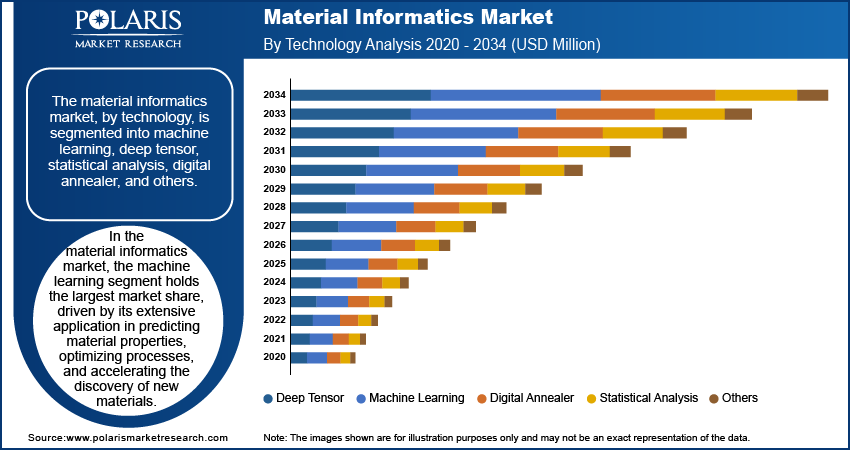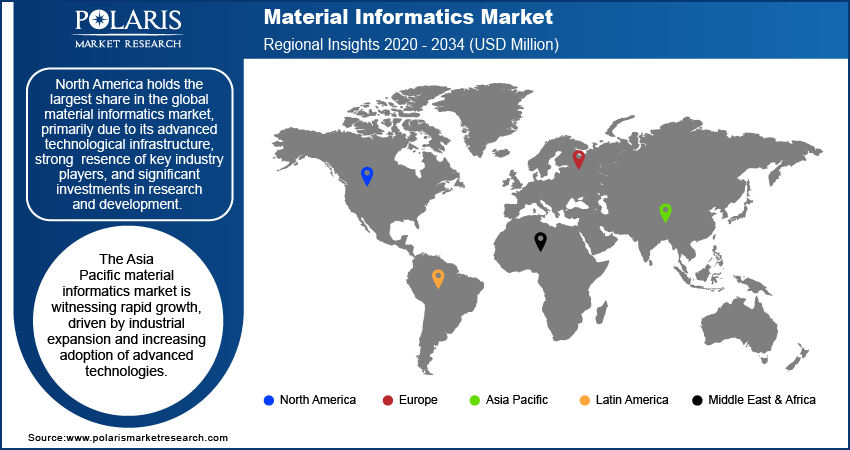
Material Informatics Market Size, Share, Trends, Industry Analysis Report: By Material Type (Elements, Chemicals, and Others), Technology (Machine Learning, Deep Tensor, Statistical Analysis, Digital Annealer, and Others), Application (Chemical & Pharmaceutical, Materials Science, Manufacturing, Food Science, Energy, and Others), and By Region (North America, Europe, Asia Pacific, Latin America, and Middle East & Africa) – Market Forecast, 2025–2034
- Published Date:Nov-2024
- Pages: 116
- Format: PDF
- Report ID: PM5256
- Base Year: 2024
- Historical Data: 2020-2023
Material Informatics Market Overview
The material informatics market size was valued at USD 154.78 million in 2024. The market is projected to grow from USD 179.92 million in 2025 to USD 705.21 million by 2034, exhibiting a CAGR of 16.4% during 2025–2034.
The global material informatics market involves the use of data-driven approaches, including artificial intelligence (AI) and machine learning (ML), to accelerate the discovery, design, and application of materials across various industries. This market is driven by the increasing demand for advanced materials in sectors such as aerospace, electronics, and energy and the rising need to reduce the time and costs associated with material development.
The integration of high-throughput experimentation with computational modeling, the growing adoption of cloud-based platforms, and the rising collaborative research efforts between academia and industry are expected to become key future trends in the market.

To Understand More About this Research: Request a Free Sample Report
Material Informatics Market Drivers and Trends Analysis
Integration of AI and Machine Learning
The integration of artificial intelligence (AI) and machine learning (ML) is rising in material discovery and development. These technologies are transforming the way materials are researched and applied, allowing for faster predictions of material properties and the optimization of complex processes. AI-driven algorithms can analyze vast datasets, identify patterns, and predict outcomes with greater accuracy than traditional methods. For example, ML models can reduce the time required for material discovery by up to 90% compared to conventional approaches, according to a study published in Nature Communications (2022). This trend is gaining momentum as more industries seek to leverage AI and ML to stay competitive in material innovation.
Shift Toward High-Throughput Experimentation
High-throughput experimentation (HTE) is becoming increasingly prevalent in the material informatics market. This approach allows researchers to conduct multiple experiments simultaneously, significantly accelerating the pace of material discovery and development. By combining HTE with computational modeling, researchers can explore a broader range of material compositions and properties in a fraction of the time. A report by ACS Publications highlights that HTE can lead to a tenfold increase in the speed of material development cycles, making it a critical trend in the market. As various industries, such as electronics, energy, and pharmaceuticals, push for faster innovation cycles, the adoption of HTE methods is expected to grow, further driving advancements in material informatics in the coming years.

Material Informatics Market Segment Insights
Material Informatics Market Assessment by Material Type
The material informatics market, by material type, is segmented into elements, chemicals, and others. The elements segment holds the largest market share owing to its widespread application across multiple industries, including electronics, aerospace, and energy. The demand for advanced elemental materials, such as rare earth elements and transition metals, is particularly high due to their critical role in the development of high-performance products and technologies. As industries continue to push for innovation, the reliance on elemental materials is expected to sustain this segment's dominant position in the market.
The chemicals segment is registering the highest growth rate within the material informatics market. The increasing need for specialized chemicals in sectors such as pharmaceuticals, agriculture, and consumer goods drives the growth. The use of material informatics to design and optimize chemical compounds is becoming more prevalent, allowing for more efficient processes and better-targeted applications. As companies invest in R&D to develop new chemical formulations, the material informatics market for this segment is projected to experience significant expansion during 2024–2032.
Material Informatics Market Evaluation by Technology
The material informatics market, by technology, is segmented into machine learning, deep tensor, statistical analysis, digital annealer, and others. In the material informatics market, the machine learning segment holds the largest market share, driven by its extensive application in predicting material properties, optimizing processes, and accelerating the discovery of new materials. Machine learning models are increasingly used to analyze vast datasets, identify patterns, and generate insights that were previously unattainable with traditional methods. The technology's adaptability and effectiveness across various industries, including automotive, electronics, and pharmaceuticals, have cemented its position as the leading segment in the market.
The digital annealer segment is experiencing the highest growth rate in the material informatics market owing to the technology's ability to solve complex combinatorial optimization problems with remarkable speed and accuracy, making it particularly valuable in material science applications that require high precision. As industries seek more efficient ways to explore material combinations and configurations, the demand for digital annealing technology is surging.
Material Informatics Market by Application
The material informatics market, in terms of application, is segmented into chemical & pharmaceutical, materials science, manufacturing, food science, energy, and others. The materials science segment holds the largest market share, reflecting its central role in the development and optimization of materials across a wide range of industries. This segment benefits from the growing demand for advanced materials with specific properties, including high strength, durability, and conductivity, which are essential in sectors such as aerospace, electronics, and automotive. The ability of material informatics to streamline the discovery and application of these materials has made it a crucial tool in materials science, driving significant investment and adoption in this segment.
The chemical & pharmaceutical segment is registering the highest growth rate in the material informatics market. The growth is driven by the increasing complexity of chemical and pharmaceutical research, where material informatics is used to design new compounds, optimize formulations, and accelerate drug discovery. The use of data-driven approaches in this segment allows for more efficient R&D processes, reducing the time and cost associated with bringing new products to market. As the pharmaceutical industry continues to evolve and the demand for innovative chemical solutions rises, the market for this segment is poised for continued expansion in the coming years.

Material Informatics Market by Regional Insights
By region, the study provides market insights into North America, Europe, Asia Pacific, Latin America, and the Middle East & Africa. North America holds the largest share in the global material informatics market, primarily due to its advanced technological infrastructure, strong presence of key industry players, and significant investments in research and development. The region's leadership in sectors such as aerospace, electronics, and pharmaceuticals further drives the adoption of material informatics solutions. Additionally, government support and funding for advanced materials research in the US and Canada bolster market growth. Europe and Asia Pacific also contribute significantly, with Europe focusing on sustainability and innovation and Asia Pacific experiencing rapid growth due to industrial expansion and increasing adoption of advanced technologies.
In Europe, the material informatics market is characterized by a strong focus on sustainability and innovation. The region is home to several leading research institutions and companies that are at the forefront of material science, particularly in the development of eco-friendly and advanced materials. The European Union's emphasis on green technologies and reducing environmental impact has led to increased adoption of material informatics for optimizing material usage and developing sustainable alternatives. Additionally, countries such as Germany, the UK, and France are investing heavily in research and development, further driving the market growth in this region.
The Asia Pacific material informatics market is witnessing rapid growth, driven by industrial expansion and increasing adoption of advanced technologies. Countries such as China, Japan, and South Korea are leading due to their strong manufacturing bases and focus on technological innovation. The region's growth is further supported by government initiatives and investments in high-tech industries, including electronics, automotive, and energy. As these industries continue to evolve and demand more efficient and effective material solutions, the adoption of material informatics is expected to accelerate, making Asia-Pacific a key growth region in the global market.

Material Informatics Market – Key Players and Competitive Analysis Report
Citrine Informatics; Kebotix; Exabyte.io; Mat3ra, Schrodinger, Inc.; Aionics, Inc.; Nutonian; DeepMaterials; Materials Zone; Arzeda; Phaseshift Technologies; ChemOS; Siemens Digital Industries Software; Accelrys; and Optibrium are among the key players in the material informatics market. These companies are actively involved in the development and application of material informatics technologies, providing solutions that span various industries, including pharmaceuticals, electronics, energy, and manufacturing.
The competitive landscape in the material informatics market is shaped by innovation and technological advancements, with companies focusing on expanding their capabilities in data-driven material discovery and design. For example, Citrine Informatics and Kebotix are recognized for their AI-driven platforms that enable faster material development and optimization. Exabyte.io and Mat3ra offer cloud-based solutions that cater to the needs of researchers and engineers in diverse industries. Schrodinger, Inc. and Optibrium are particularly known for their contributions to the pharmaceutical sector, where their platforms aid in the discovery and development of new compounds.
Competition in the market is also influenced by strategic partnerships and collaborations, as companies seek to leverage each other's strengths to enhance their offerings. Siemens Digital Industries Software and Dassault Systèmes, through their acquisition of Accelrys, have integrated material informatics into their broader product lifecycle management (PLM) solutions, providing a comprehensive approach to material development. Additionally, startups such as DeepMaterials and Phaseshift Technologies are gaining traction by offering specialized solutions that address specific challenges in material science, further intensifying competition in the market.
Citrine Informatics is a prominent company in the material informatics market, known for its AI-driven platform that accelerates the discovery and optimization of materials. Citrine's platform leverages machine learning to analyze vast datasets, enabling companies to predict material properties and reduce development time.
Kebotix is another key player in the market, focusing on automating the process of material discovery using AI and robotics. Their technology enables faster experimentation and data analysis, which is crucial for industries looking to innovate quickly.
Key Companies in the Material Informatics Market
- Citrine Informatics
- Kebotix
- Exabyte.io
- Mat3ra
- Schrodinger, Inc.
- Aionics, Inc.
- Nutonian
- DeepMaterials
- Materials Zone
- Arzeda
- Phaseshift Technologies
- ChemOS
- Siemens Digital Industries Software
- Accelrys
- Optibrium
Material Informatics Industry Developments
- In June 2024, Citrine Informatics announced a new collaboration with a leading automotive manufacturer to develop advanced materials for electric vehicle batteries, highlighting the company's ongoing role in driving innovation within key industries.
- In March 2024, Kebotix secured a significant investment to expand its AI capabilities, aiming to enhance its platform’s ability to discover and design new materials. This development underscores Kebotix's commitment to advancing the field of material informatics through cutting-edge technology.
Material Informatics Market Segmentation
By Material Type Outlook (Revenue – USD Million, 2020–2034)
- Elements
- Chemicals
- Others
By Technology Outlook (Revenue – USD Million, 2020–2034)
- Machine Learning
- Deep Tensor
- Statistical Analysis
- Digital Annealer
- Others
By Application Outlook (Revenue – USD Million, 2020–2034)
- Chemical & Pharmaceutical
- Materials Science
- Manufacturing
- Food Science
- Energy
- Others
By Regional Outlook (Revenue – USD Million, 2020–2034)
- North America
- US
- Canada
- Europe
- Germany
- France
- UK
- Italy
- Spain
- Netherlands
- Russia
- Rest of Europe
- Asia Pacific
- China
- Japan
- India
- Malaysia
- South Korea
- Indonesia
- Australia
- Vietnam
- Rest of Asia Pacific
- Middle East & Africa
- Saudi Arabia
- UAE
- Israel
- South Africa
- Rest of Middle East & Africa
- Latin America
- Mexico
- Brazil
- Argentina
- Rest of Latin America
Material Informatics Market Report Scope
|
Report Attributes |
Details |
|
Market Size Value in 2024 |
USD 154.78 million |
|
Market Size Value in 2025 |
USD 179.92 million |
|
Revenue Forecast in 2034 |
USD 705.21 million |
|
CAGR |
16.4% from 2025 to 2034 |
|
Base Year |
2024 |
|
Historical Data |
2020–2023 |
|
Forecast Period |
2025–2034 |
|
Quantitative Units |
Revenue in USD Million and CAGR from 2025 to 2034 |
|
Report Coverage |
Revenue Forecast, Market Competitive Landscape, Growth Factors, and Trends |
|
Segments Covered |
|
|
Regional Scope |
|
|
Competitive Landscape |
|
|
Report Format |
|
|
Customization |
Report customization as per your requirements with respect to countries, regions, and segmentation. |
FAQ's
The global material informatics market size was valued at USD 154.78 million in 2024 and is projected to grow to USD 705.21 million by 2034
The global market is projected to register a CAGR of 16.4% during 2025–2034.
North America accounted for the largest share of the global market.
Citrine Informatics; Kebotix; Exabyte.io; Mat3ra; Schrodinger, Inc.; Aionics, Inc.; Nutonian (acquired by DataRobot); DeepMaterials; Materials Zone; Arzeda; Phaseshift Technologies; ChemOS; Siemens Digital Industries Software; Accelrys (acquired by Dassault Systèmes); and Optibrium are a few key players in the material informatics market.
The elements segment accounted for the largest share of the global market.
The machine learning segment accounted for the largest share of the global market.
